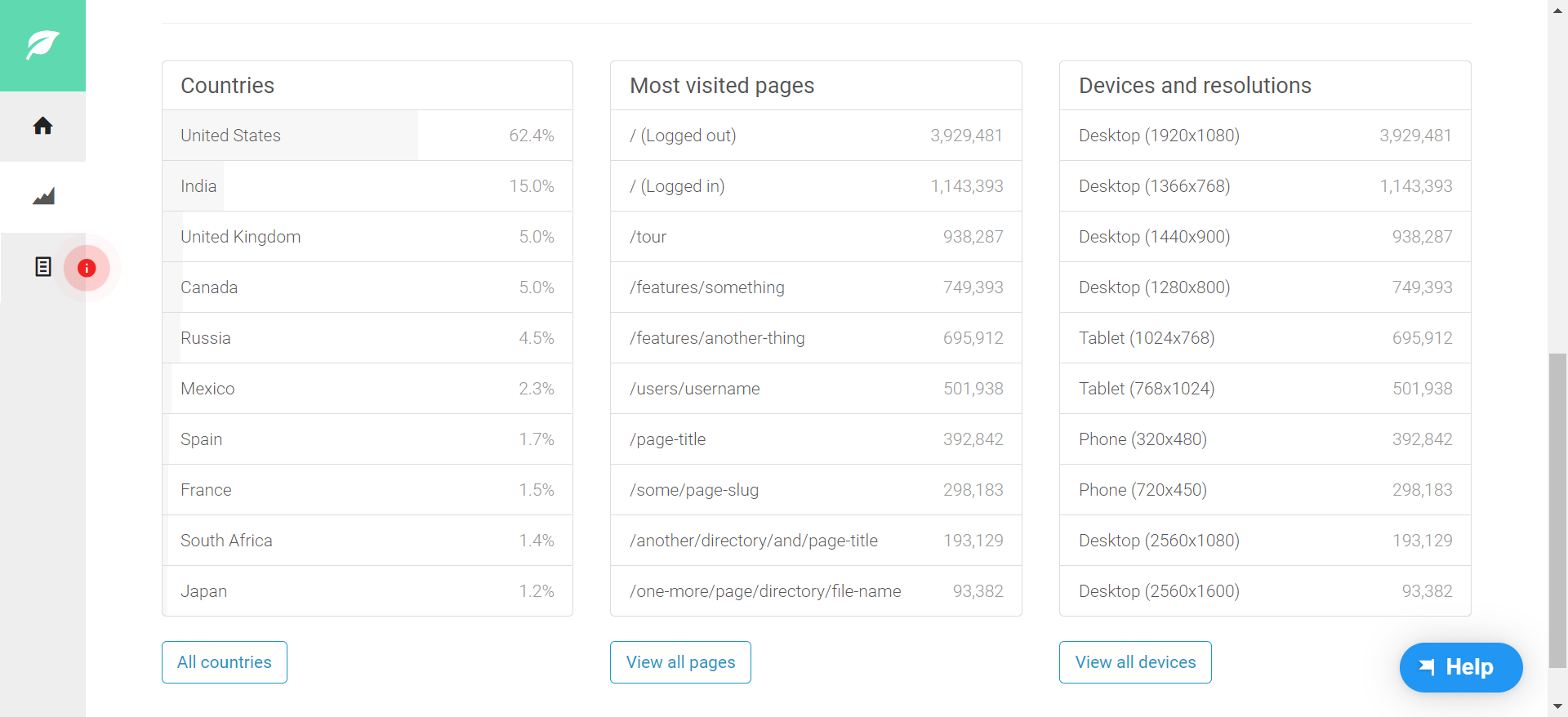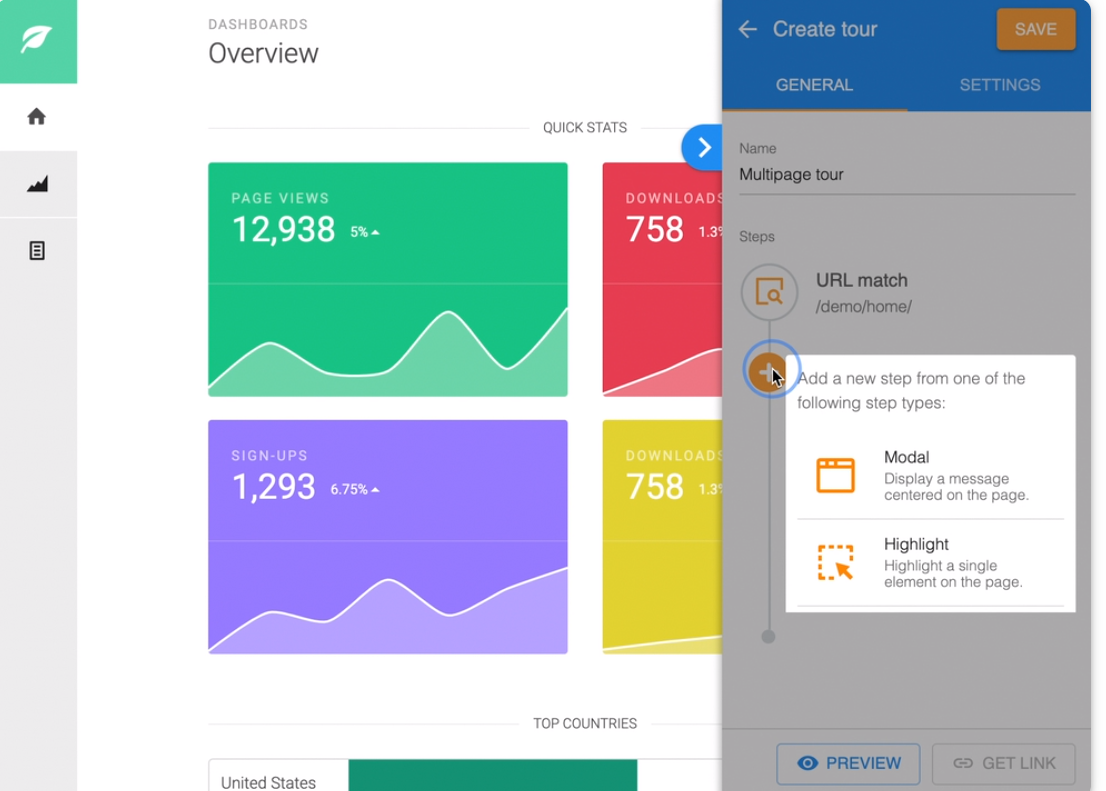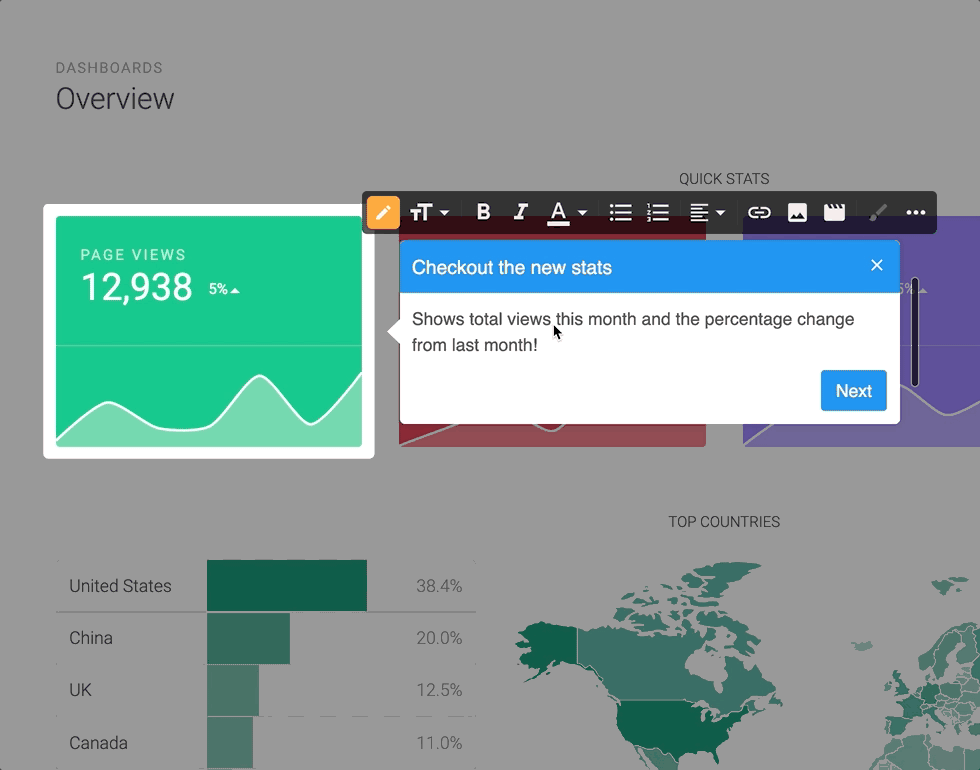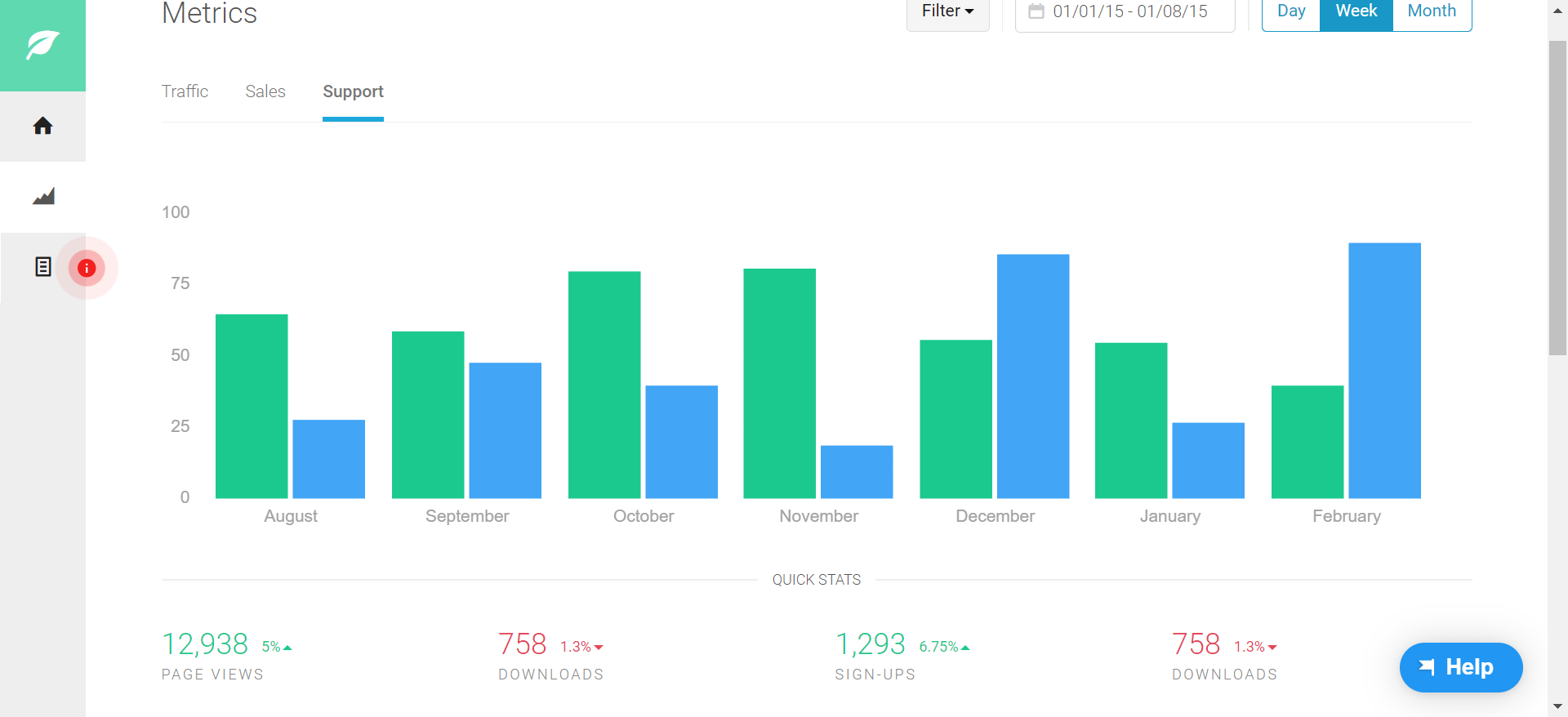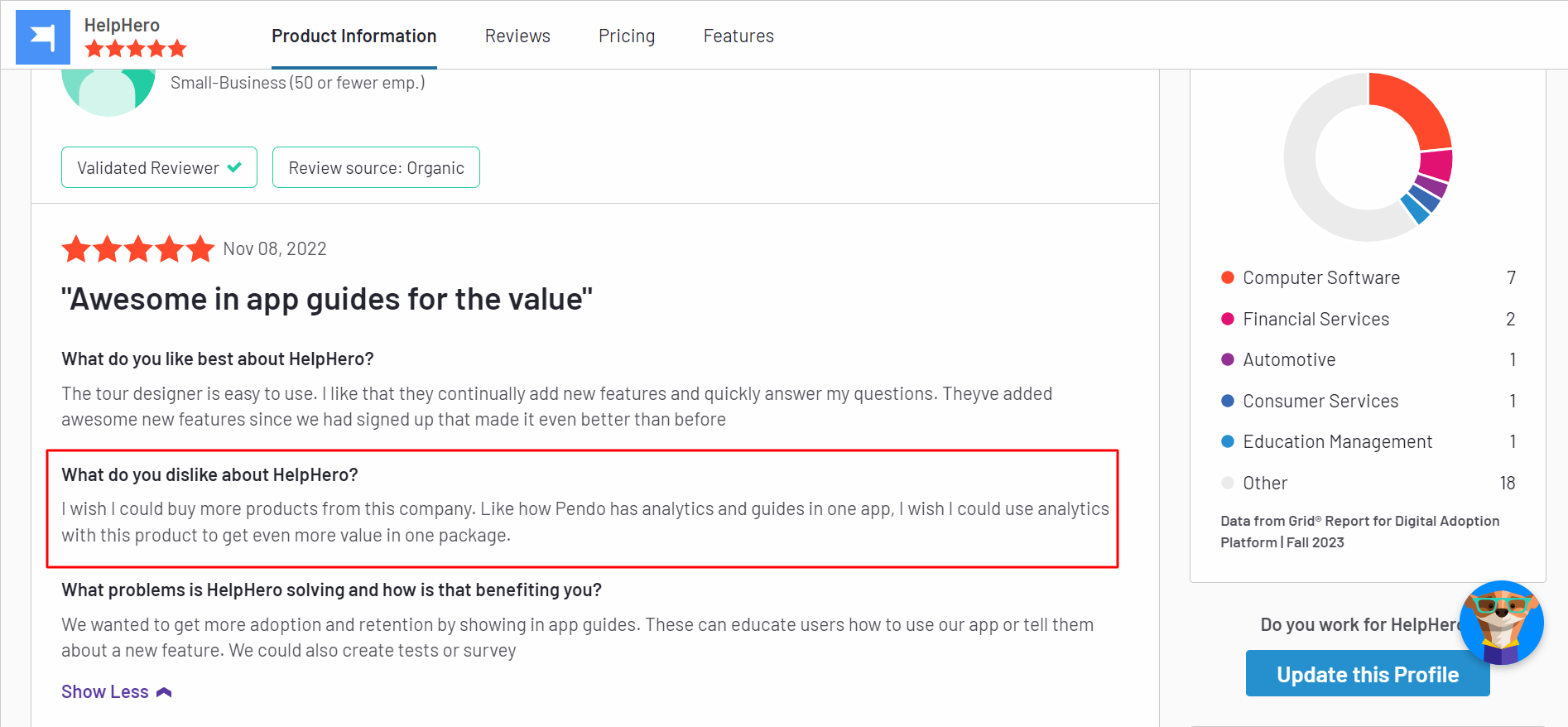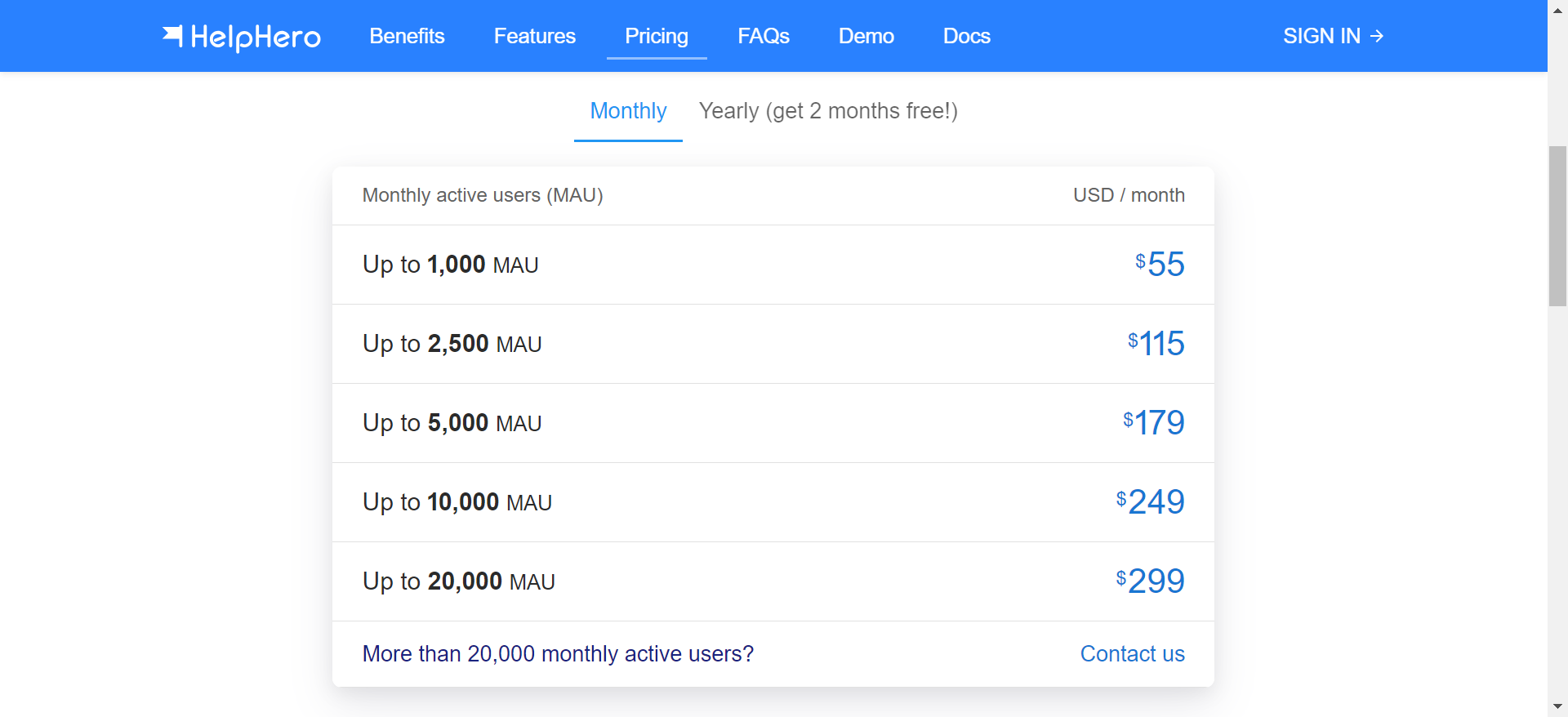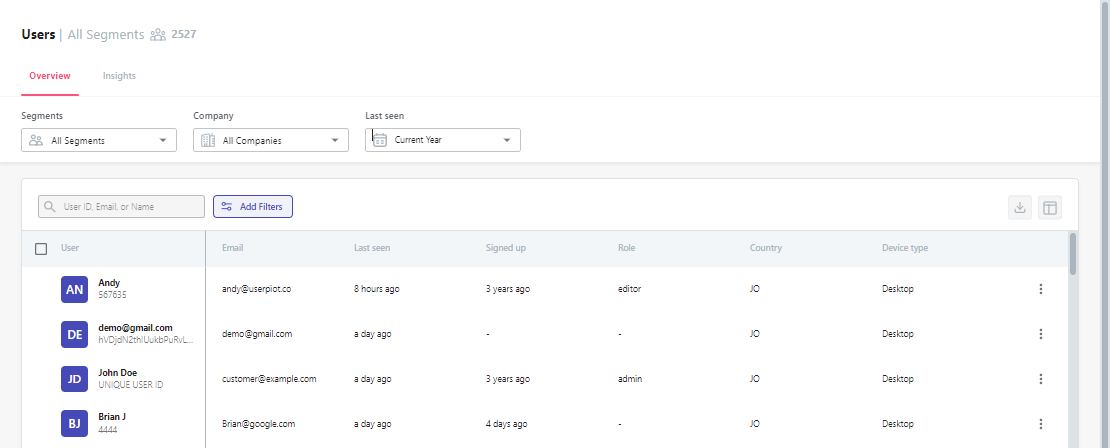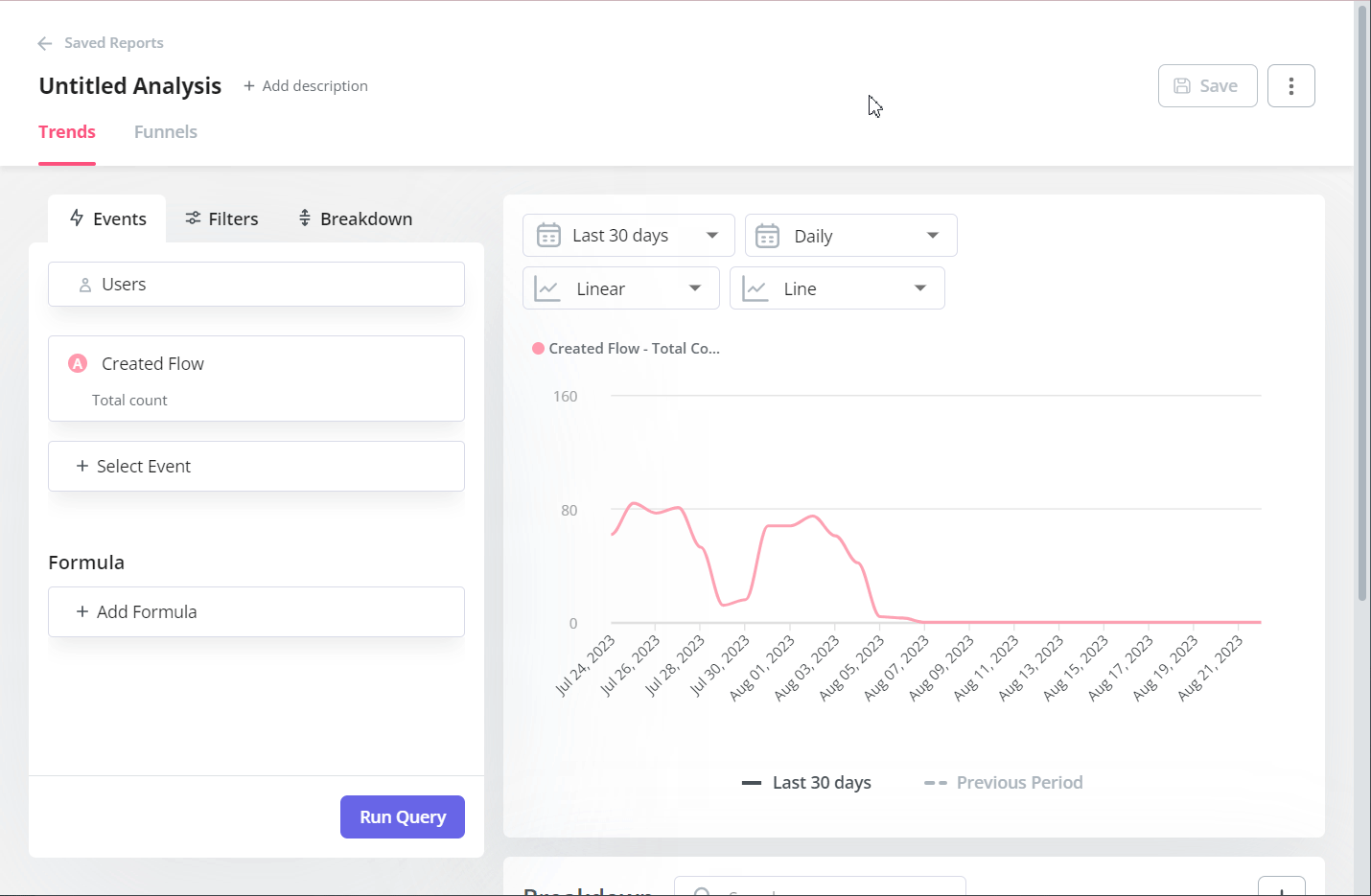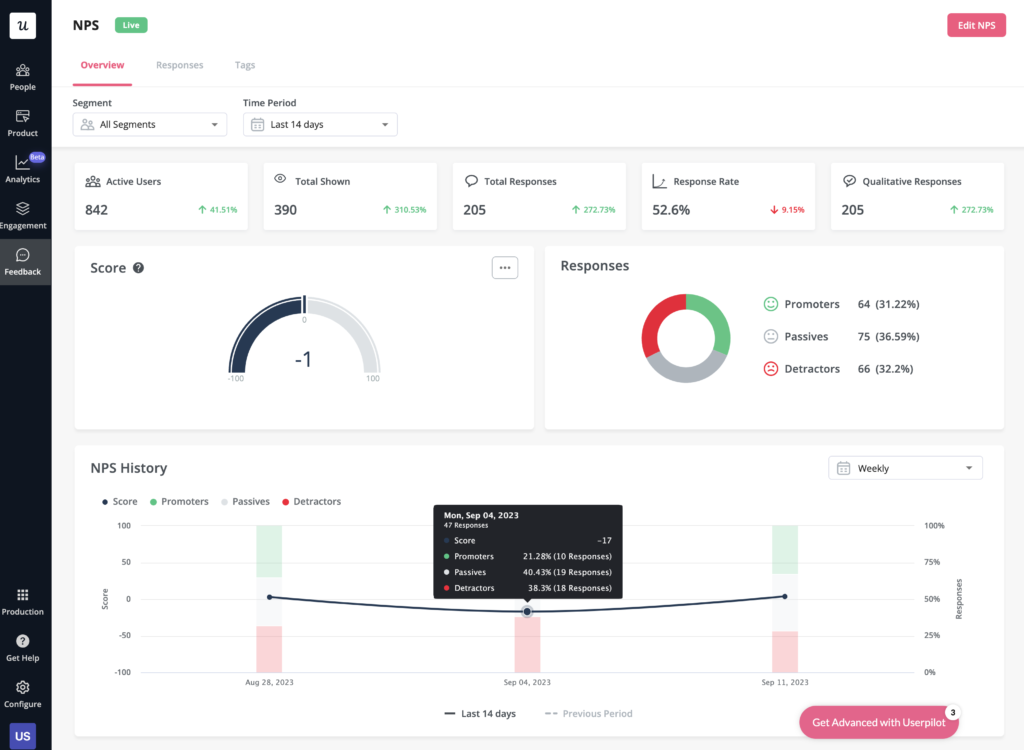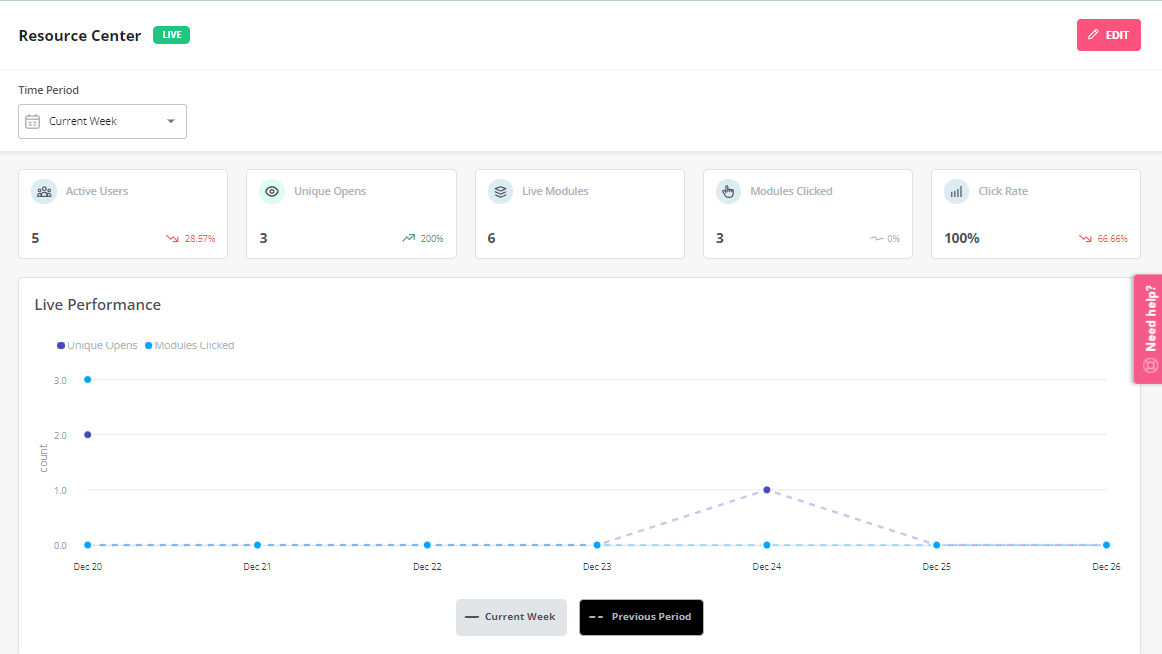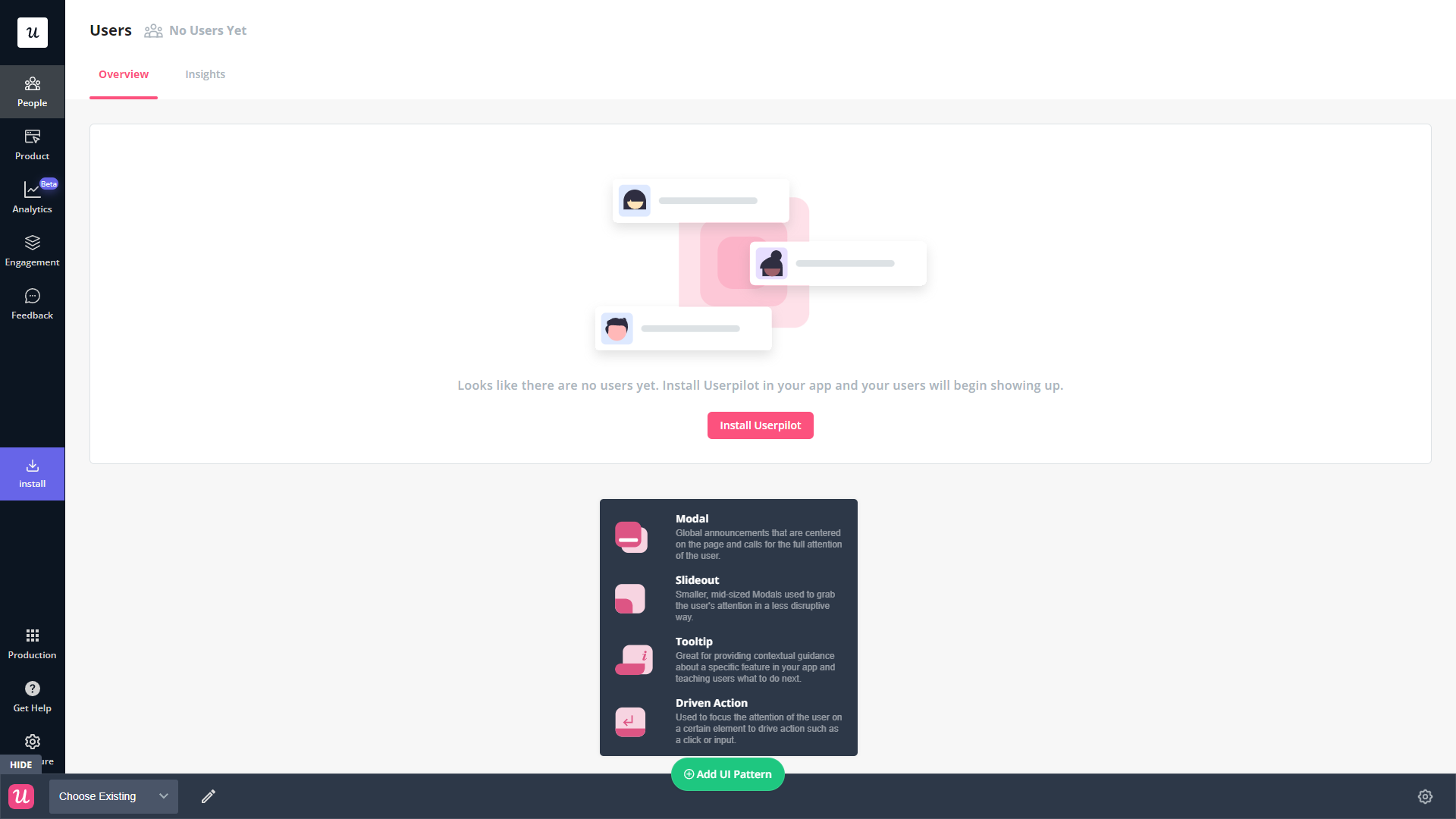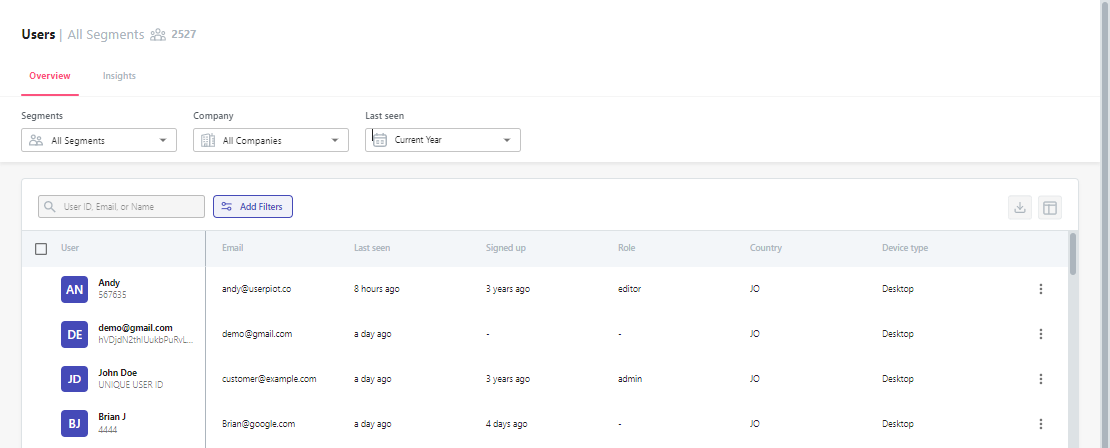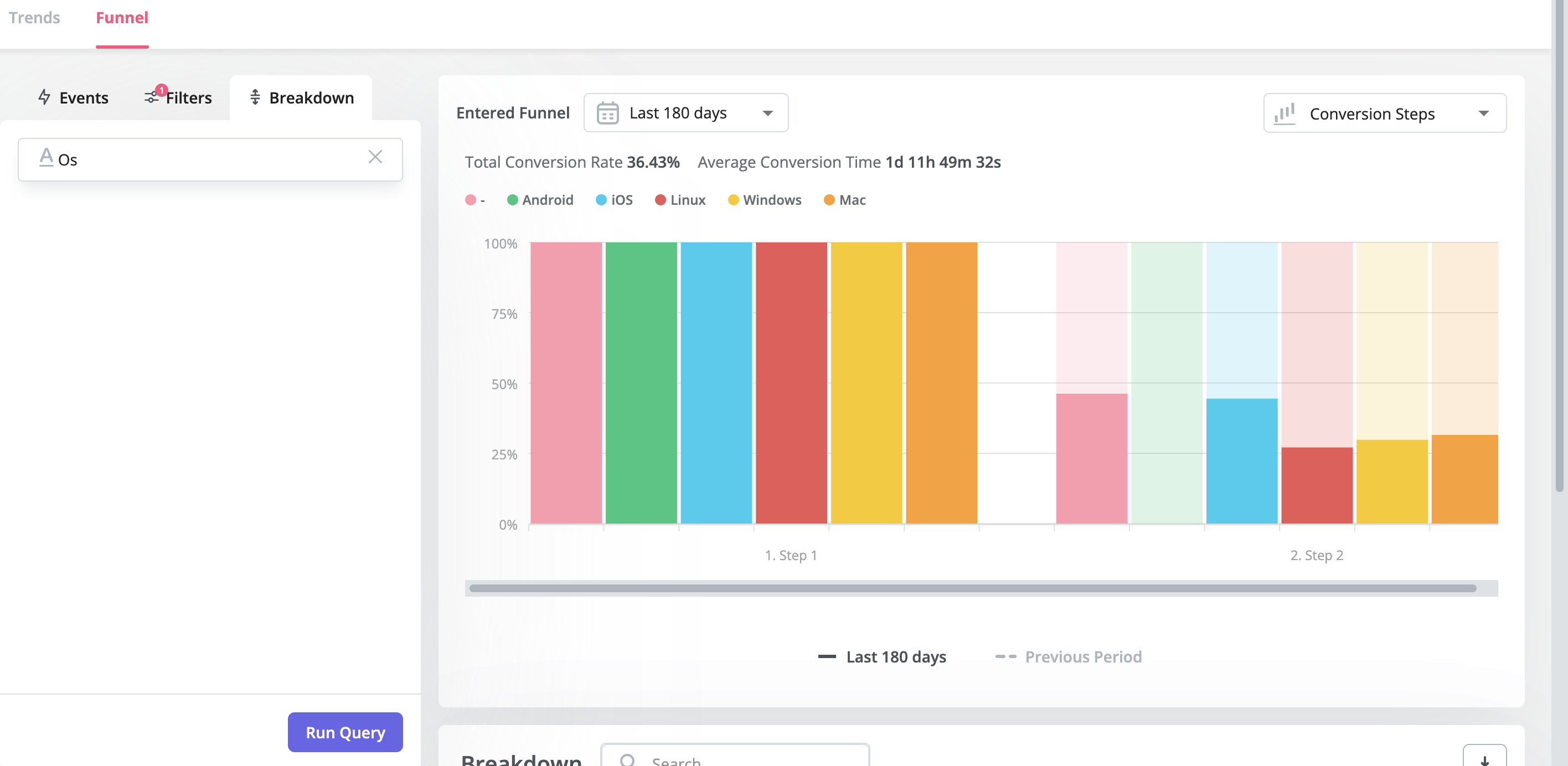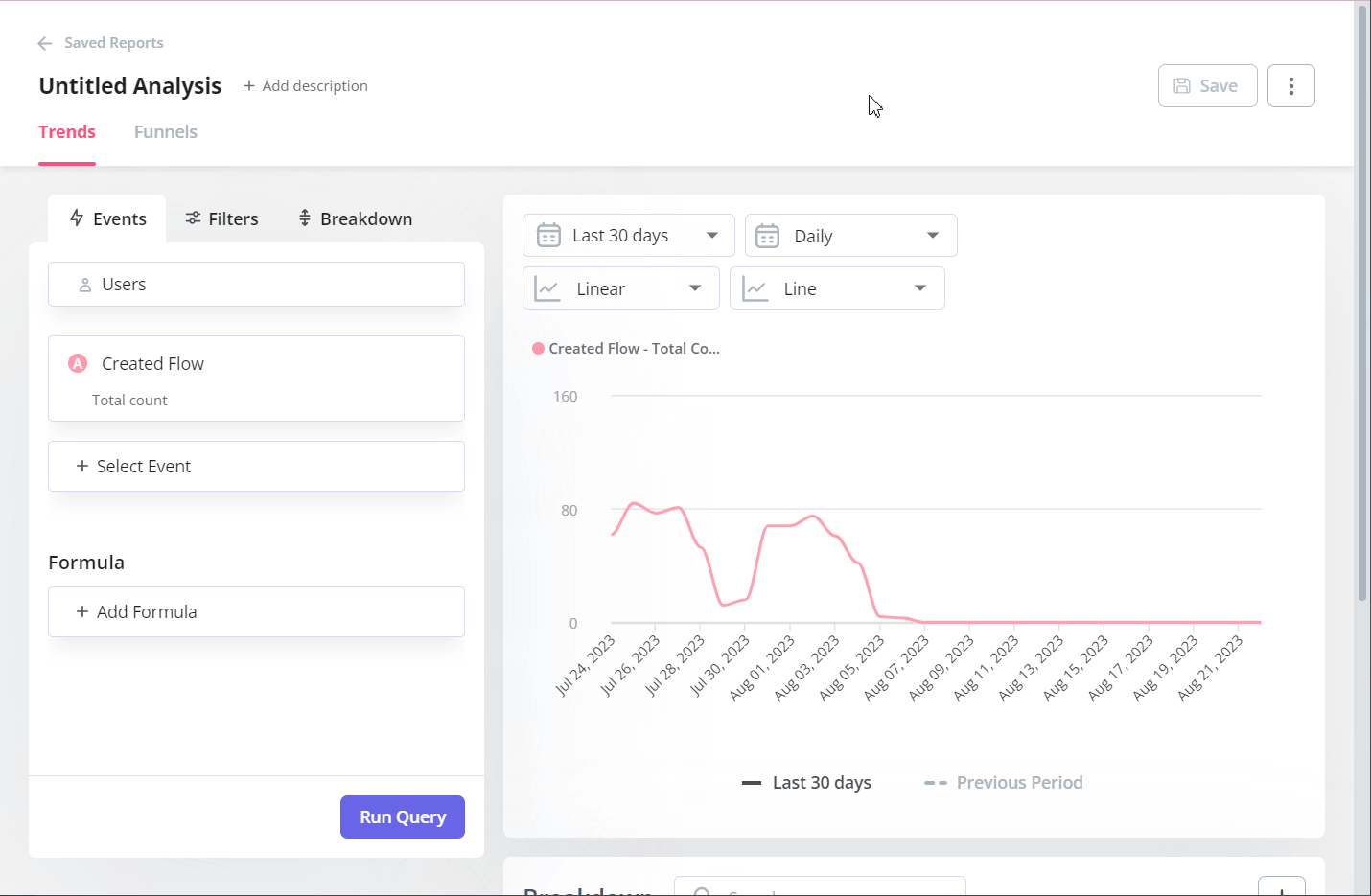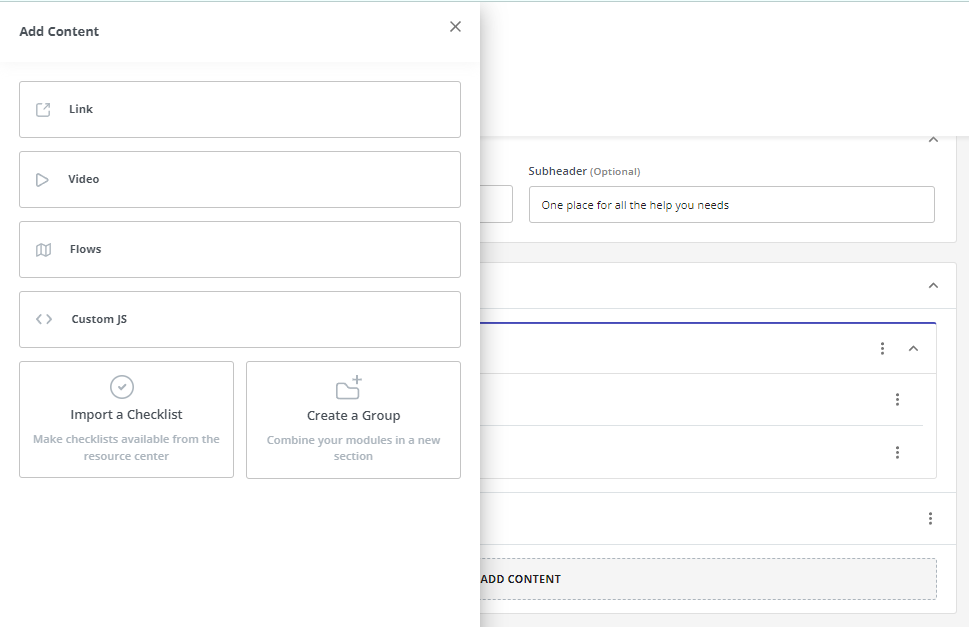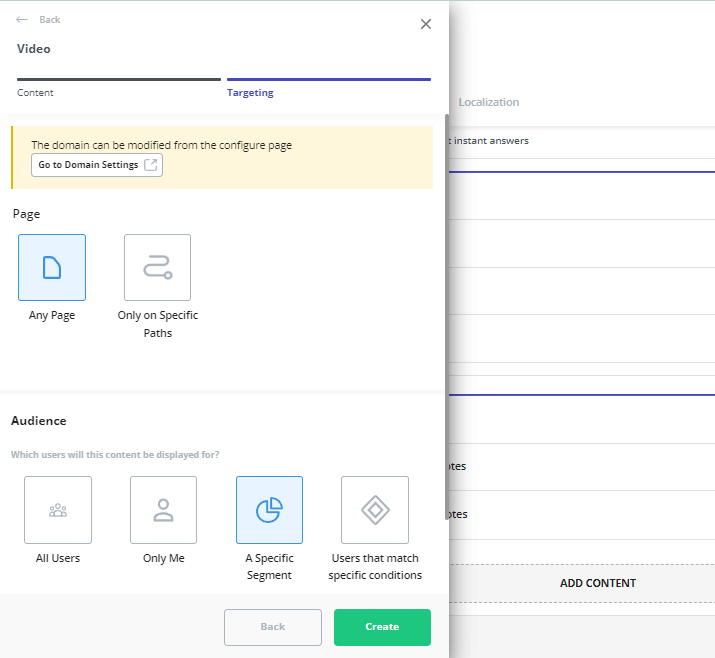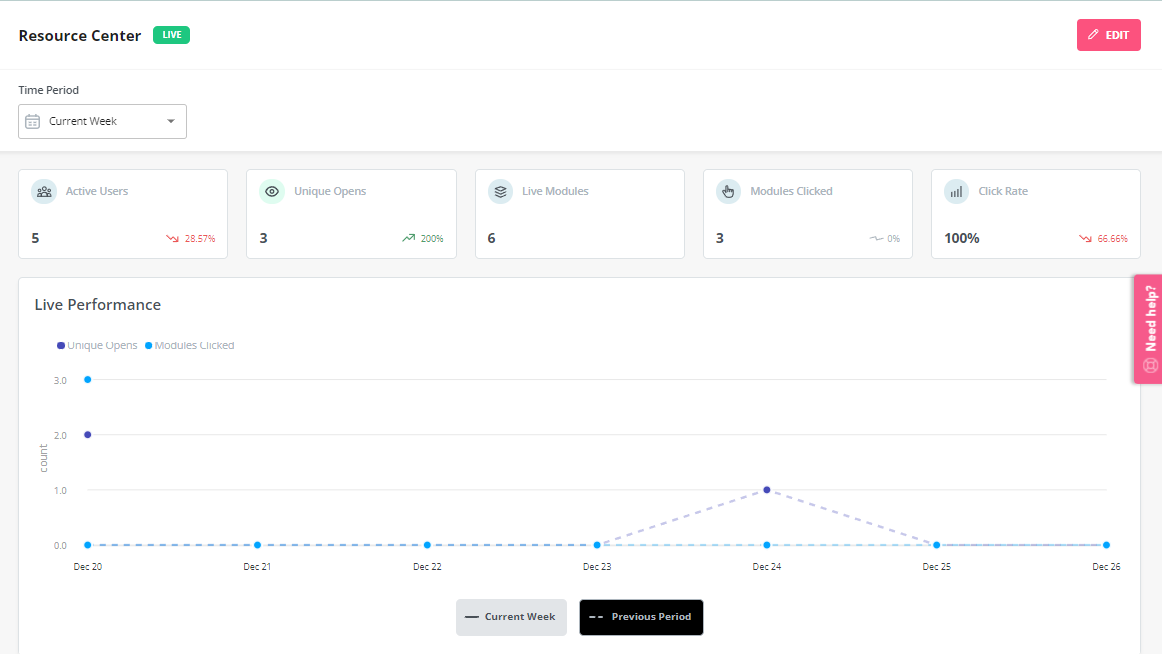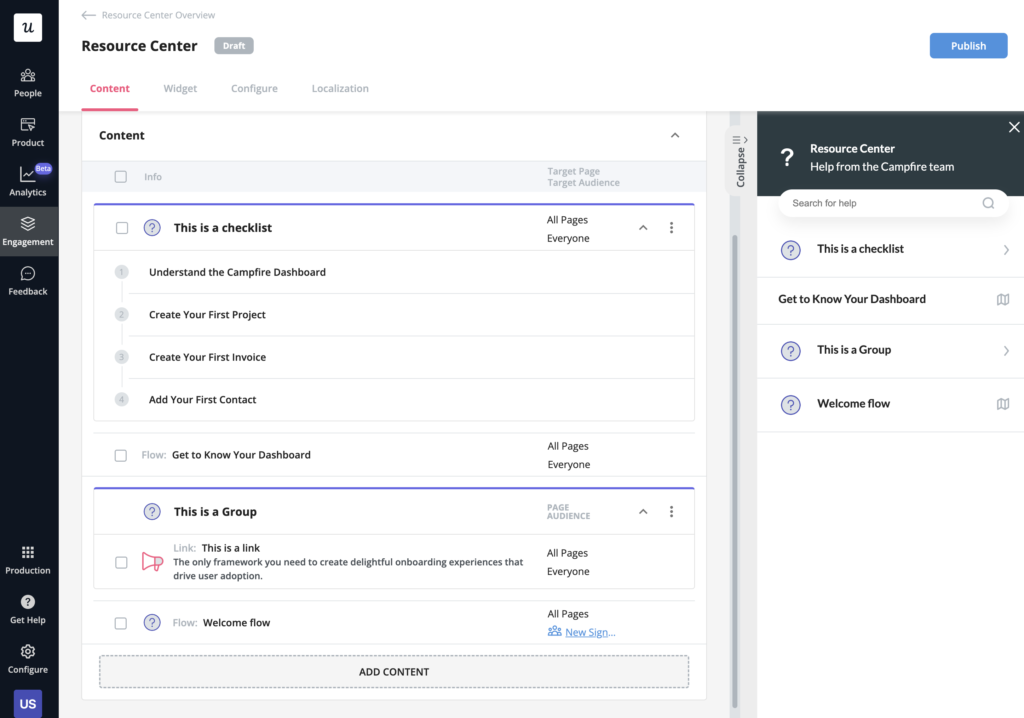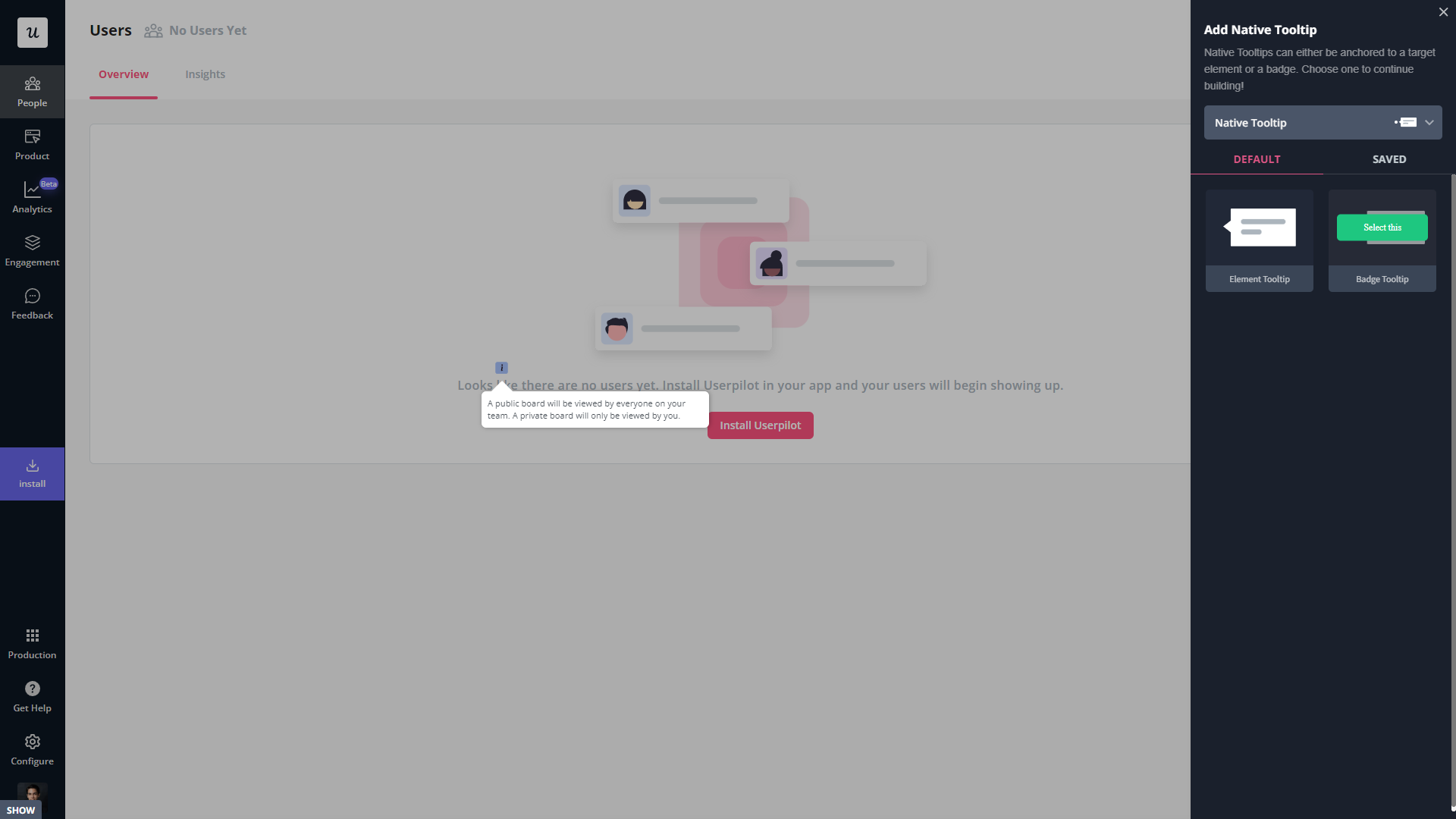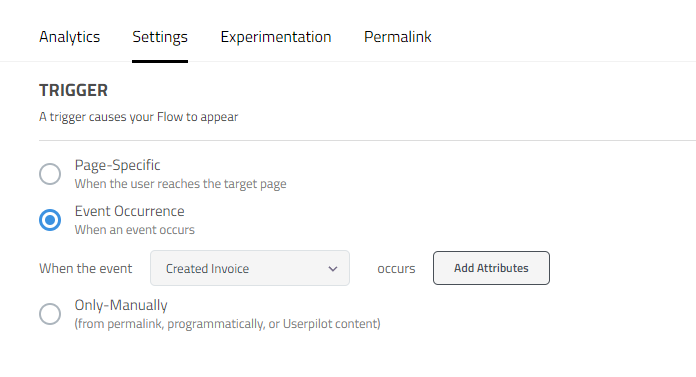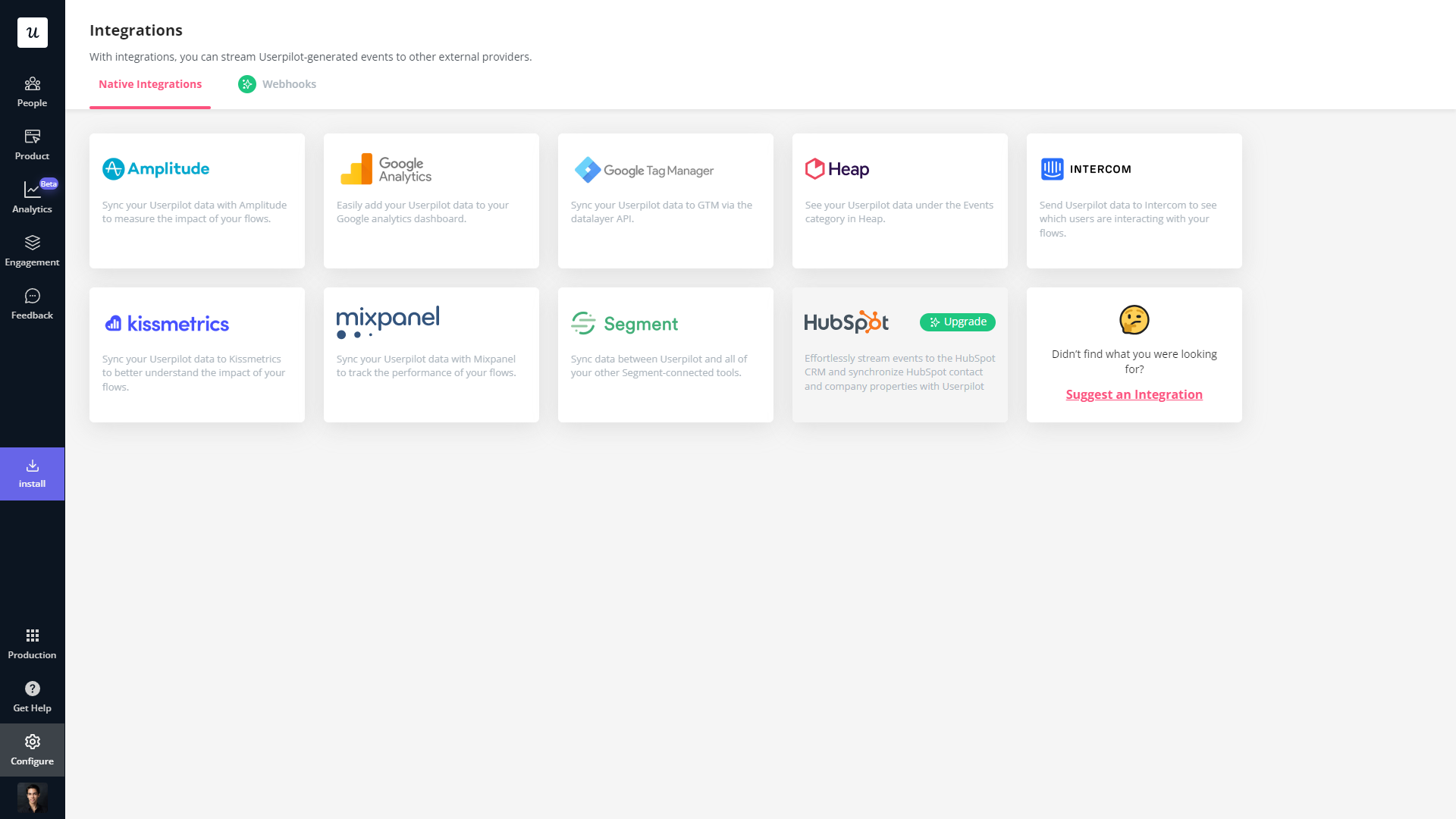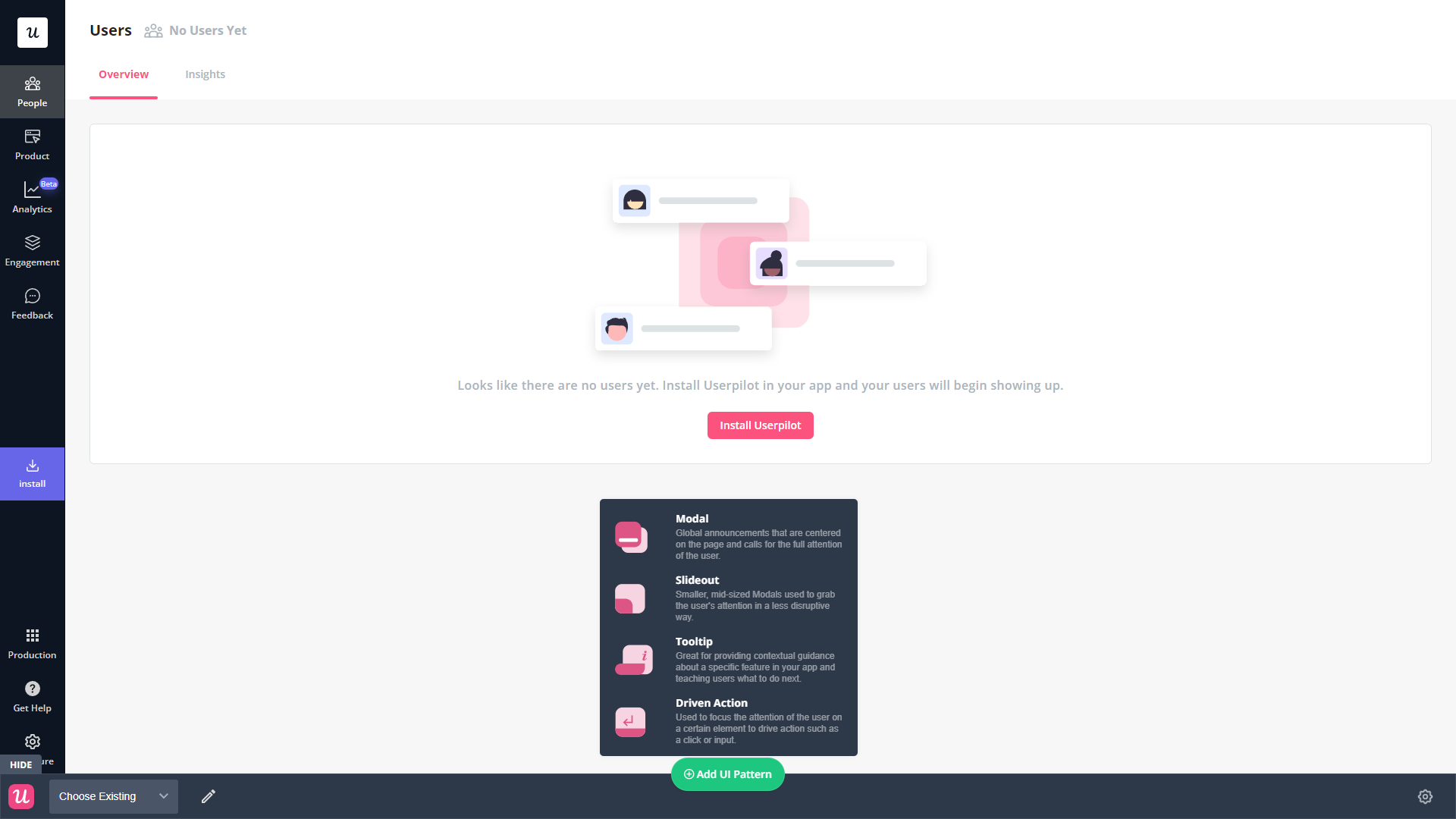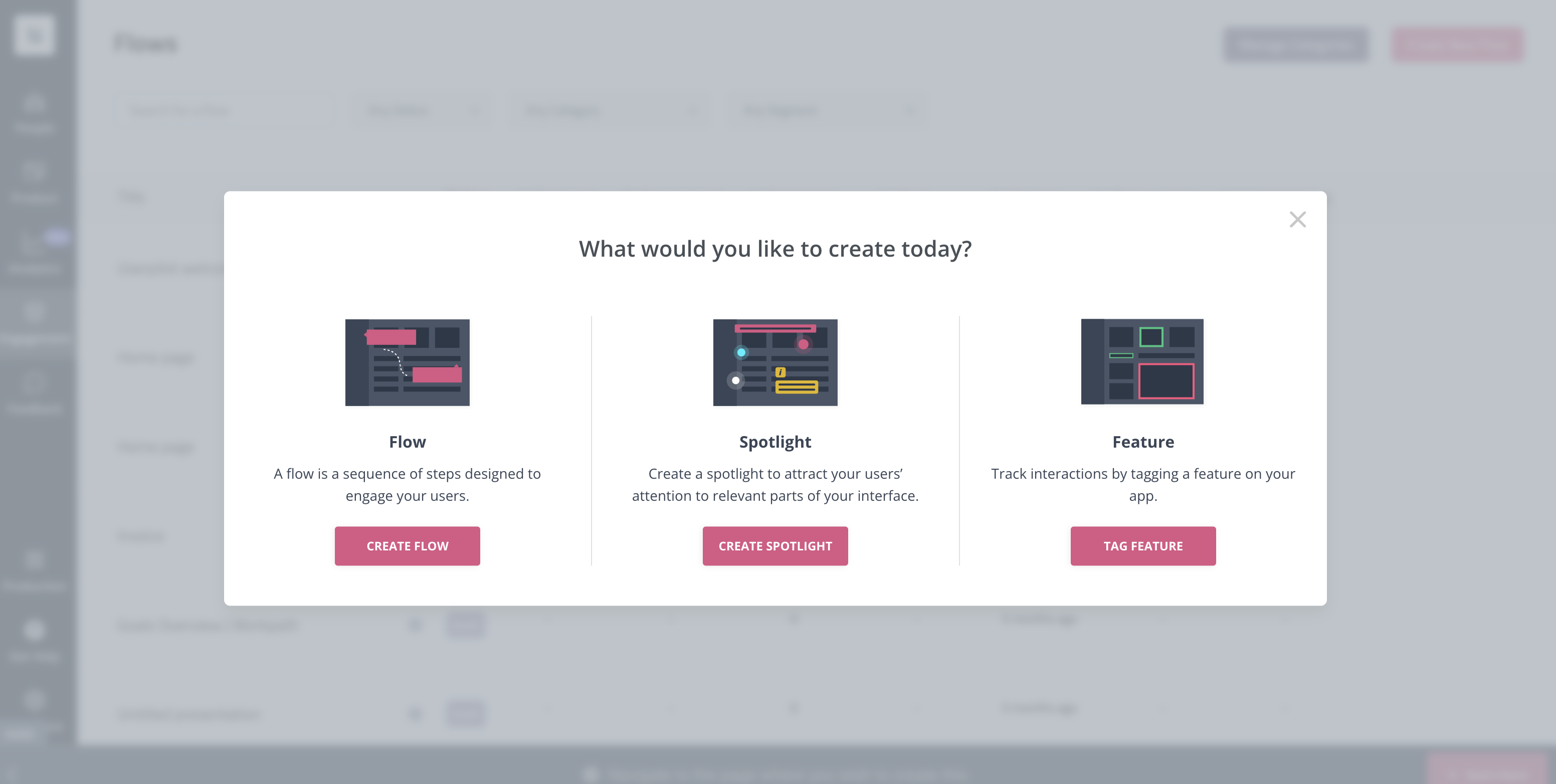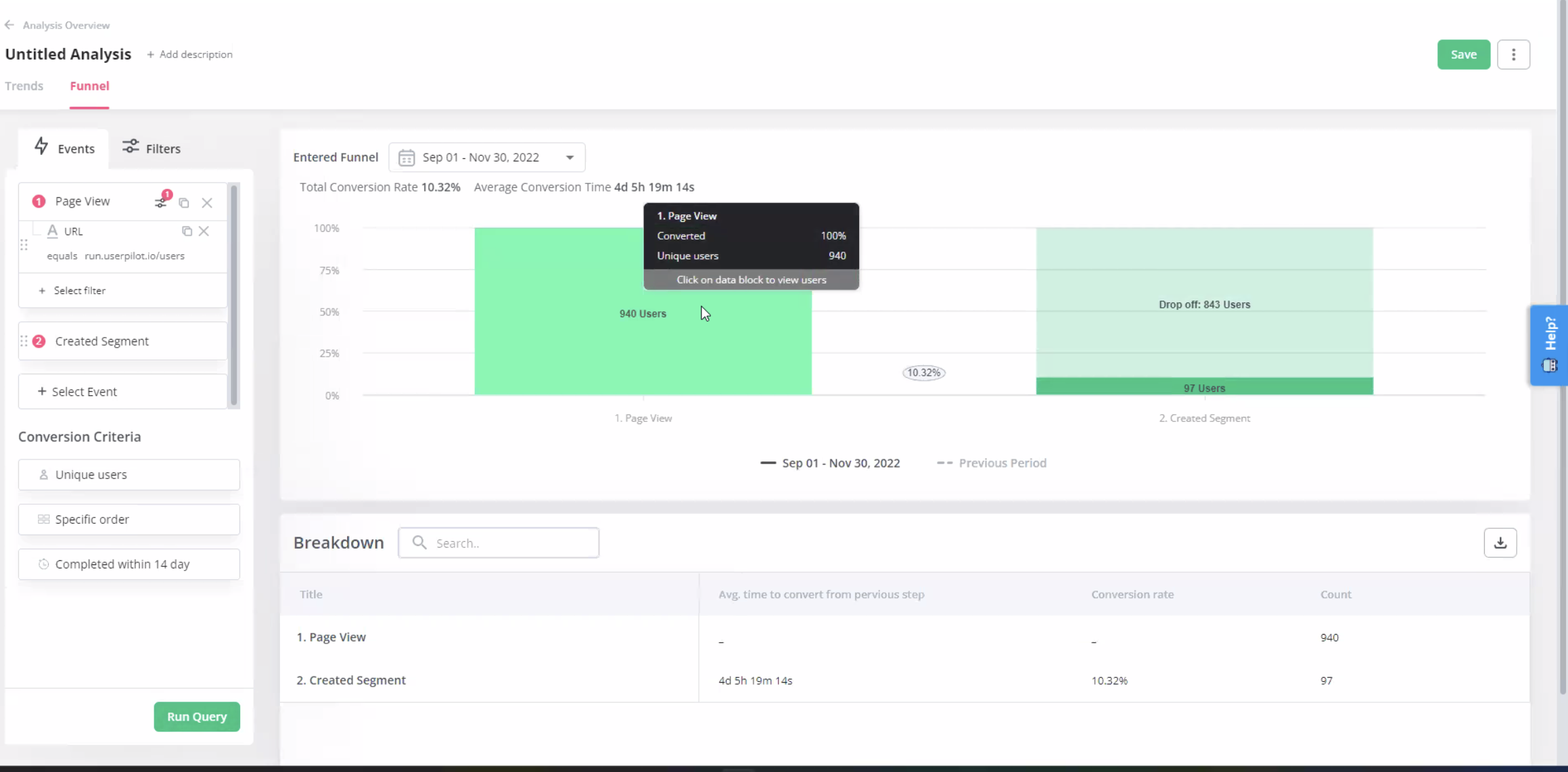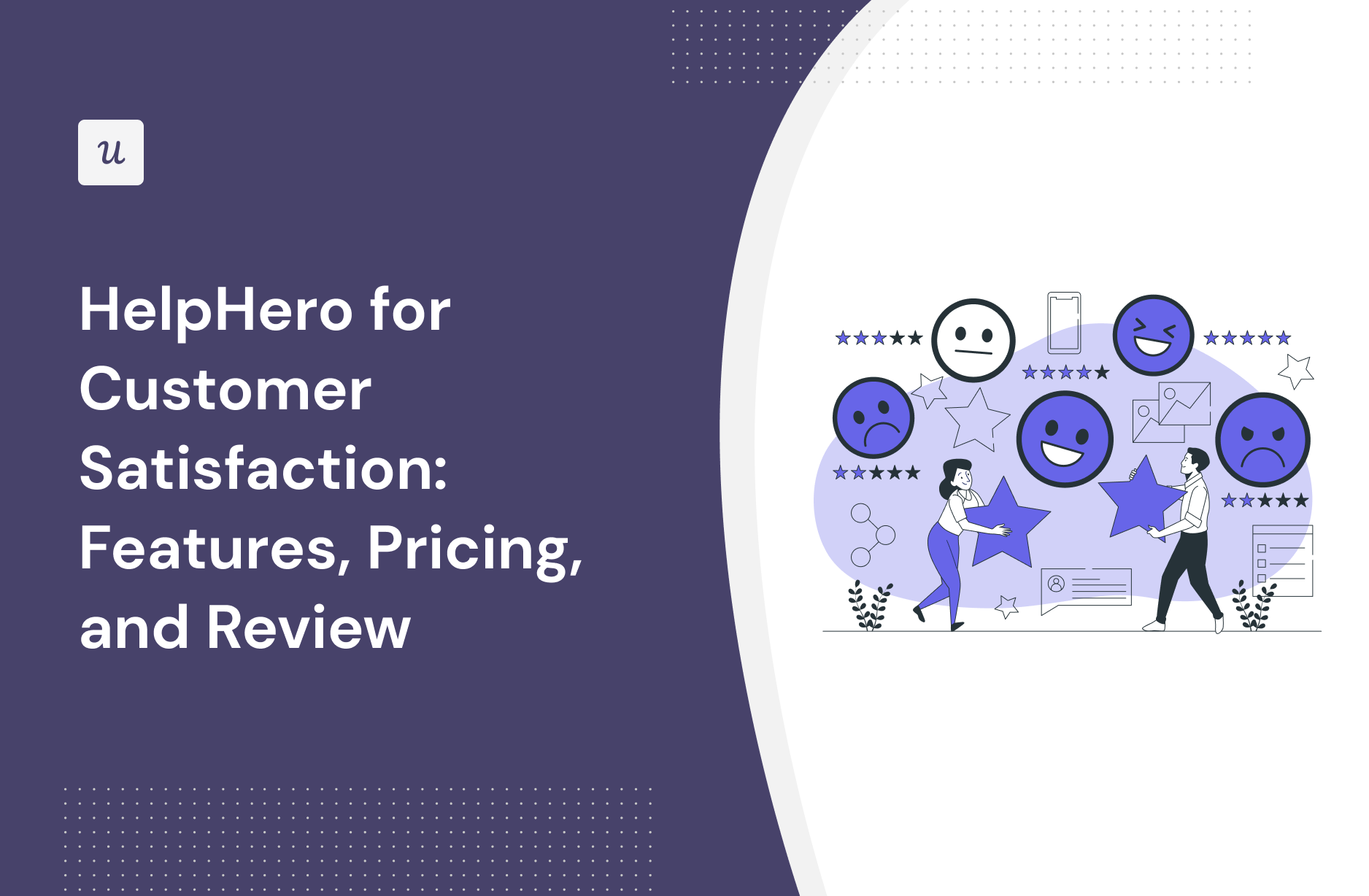
Try Userpilot Now
See Why 1,000+ Teams Choose Userpilot

Is HelpHero a good choice for measuring customer satisfaction?
- HelpHero is a good choice for Customer satisfaction and it comes with features such as user journey mapping, self service support, in-app support, and Interactive user guides.
- Let’s look at the most common limitations of HelpHero and why you might need HelpHero’s alternatives:
- You want flexible user onboarding flows: HelpHero’s user onboarding features primarily support linear paths with minimal branching capabilities. This limitation can hinder the creation of more sophisticated and adaptable onboarding experiences, which is crucial for addressing the diverse needs of users.
- You want advanced interactivity options: HelpHero’s onboarding tools are somewhat restricted when creating interactive elements beyond basic text copy and buttons. To engage users effectively, especially in complex or feature-rich applications, a lack of interactive components can be a significant drawback.
- Inability to address specific user queries: HelpHero’s onboarding flow doesn’t allow users to drill into specific issues or questions they may have during the onboarding process. This limitation can make it challenging to provide real-time assistance and guidance to users, potentially leading to frustration or increased support requests.
- If you’re looking for a better option for Customer satisfaction, Userpilot exceeds both functionality and value for money compared to HelpHero
- Ready to see Userpilot in action? Schedule a demo today to explore its powerful Customer satisfaction capabilities firsthand.
Must have features of Customer satisfaction tools
When choosing a customer satisfaction tool, it’s important to consider its ability to measure satisfaction, predict loyalty, and provide insights. Let’s explore these top features:
- No-code in-app surveys: Short questionnaire surveys like NPS, CSAT, and CES to help measure customer loyalty, satisfaction level, and experience without coding.
- Product usage analytics: An indirect feedback feature to track user interactions and identify popular and overlooked features.
- Passive feedback: These are in-app feedback widgets at various interaction points, allowing customers to provide feedback voluntarily and on their terms.
- Self-help resource center: An intuitive self-service support that quickly guides users to solutions – reducing friction and providing timely assistance for a better user experience.
- Customizable survey templates: These enable you to adjust the survey design using themes, helping it blend in with your brand and ensuring that the feedback forms integrate seamlessly into your user interface.
- Localization: For a global reach, ensure the tool offers customization and translation for various languages.
- Time-based triggers: To capture feedback throughout the customer journey, opt for tools that trigger surveys based on specific time intervals and post-event interactions.
HelpHero features for Customer satisfaction
With HelpHero, you can give your users the guidance they need before they ask for it with contextual product tours, thereby improving customer experience.
- Real-Time Engagement: The use of hotspots and tooltips allows for on-demand assistance. Customers can access contextual hints, feature explanations, and prompts at their convenience, enhancing their understanding of your product or service. This real-time engagement improves user satisfaction and reduces frustration.
- Performance Optimization: HelpHero’s analytics and optimization features are invaluable for improving the customer experience. You can identify pain points and areas that require improvement by tracking user interactions and completion rates.
When it comes to using surveys to improve customer experience, HelpHero lags. With Userpilot, you can gain customer experience insights by tracking user data, feature usage, events, survey statistics, and more.
HelpHero’s user journey mapping
A journey map is a visual representation outlining the entire customer experience from discovery to conversion and beyond.
However, HelpHero doesn’t offer user journey mapping capabilities. You will need a more advanced tool for this.
HelpHero’s self service support
Implementing a self-service approach will help you scale up without spending a fortune to maintain sufficient support quality.
Guided tours serve as a primer that introduces users to how a product works for the first time on HelpHero.
Outside of that, there are no self-help and knowledge repository integrations. Below is the little HelpHero offers in terms of self-service support:
- Interactive Walkthroughs: HelpHero allows the creation of step-by-step guides within the app, leading users through various functions and features. These walkthroughs can be customized and triggered based on user actions.
- Tooltips: It offers tooltip support, which provides contextual information when a user hovers over or clicks on specific elements in the app. This is useful for explaining buttons, features, or UI elements that take time to be intuitive.
- Hotspots: HelpHero enables the integration of hotspots within the app’s interface. These attention-grabbing indicators prompt users to explore or discover new features often used to highlight updates or underused aspects of the application.
However, HelpHero doesn’t provide an in-app resource center, necessary for self-service support. If you are looking for a better option to optimize your support, you should look into alternatives, such as Userpilot.
HelpHero’s in-app support
In-app support in SaaS refers to the service features that customers can use to receive help directly within the product interface besides connecting with your customer service team.
Here are three key features of HelpHero for in-app support:
- Interactive Walkthroughs: HelpHero allows the creation of step-by-step guides within the app, leading users through various functions and features. These walkthroughs can be customized and triggered based on user actions.
- Tooltips: It offers tooltip support, which provides contextual information when a user hovers over or clicks on specific elements in the app. This is useful for explaining buttons, features, or UI elements that might take time to be intuitive.
- Hotspots: HelpHero enables the integration of hotspots within the app’s interface. These attention-grabbing indicators prompt users to explore or discover new features often used to highlight updates or underused aspects of the application.
HelpHero’s Interactive user guides
An interactive user guide is a combination of prompts used when onboarding users to help them understand how to use your product.
There are two main types of user guides: full product tours (which tend to be more detailed and time-consuming) and interactive manuals (using tooltips and real-time guidance to provide more contextual help to your customers).
HelpHero offers one type — which is product tours.
If you want to get the best out of interactive user guides, you need a better alternative, such as Userpilot.
What are the pros and cons of HelpHero?
HelpHero’s pros
HelpHero is an effective tool in the world of user onboarding and product adoption. Let’s dive into the pros of using HelpHero:
- Intuitive No-Code Product Tour Builder: HelpHero provides an easy-to-use, no-code builder that simplifies creating onboarding and product adoption flows.
- Diverse UI Patterns: With HelpHero, you have many UI patterns. Whether you prefer banners, tooltips, hotspots, or checklists, you can customize your user engagement just as you want. Regardless of your plan, you’ll have access to all UI patterns, ensuring you get value right from the entry-level plan.
- Engaging Walkthroughs: Create interactive walkthroughs tailored to specific user segments, making onboarding a breeze and driving product adoption.
- In-App Help: HelpHero enables you to build a resource center with self-service support, which can be customized to match your branding. You can choose from various help options, including videos, in-app flows, chat, and more.
- Easy & Affordable: HelpHero is a powerful and easy-to-use onboarding tool that is also cost-effective.
- Advanced Customer Support: With a comprehensive system, you can give users the guidance they need before they ask for it with contextual product tours.
- Onboarding Analytics and Segmentation: Analyze product usage and in-app flow engagement with HelpHero’s advanced analytics. You can also create user segments based on this data, allowing for highly targeted user interactions and improvements in the user experience.
HelpHero’s cons
Overall, HelpHero is a good customer onboarding software, but it has a few limitations that make it less than ideal for some businesses.
- Limited Features: HelpHero does not offer all of the features that some businesses need for customer onboarding, such as the ability to create custom onboarding flows or to track customer progress in real-time.
- Limited Customization Options: HelpHero’s customization capabilities are limited, which may not suit businesses with unique branding or design needs.
- A/B Testing is only available to technical users who can code.
- Integration Challenges: Integrating HelpHero with certain software and systems can be more complex and less seamless than some alternatives.
What do users say about HelpHero?
Does HelpHero offer a great onboarding and walkthrough experience? Let’s see a good review of HelpHero on G2:
“Easy and fast way to implement onboarding for your apps”
Very easy to implement onboarding tutorials, almost no technical skills needed. Windows can target CSS elements. Powerful funnel system. Cheapest solution of this kind I have found.
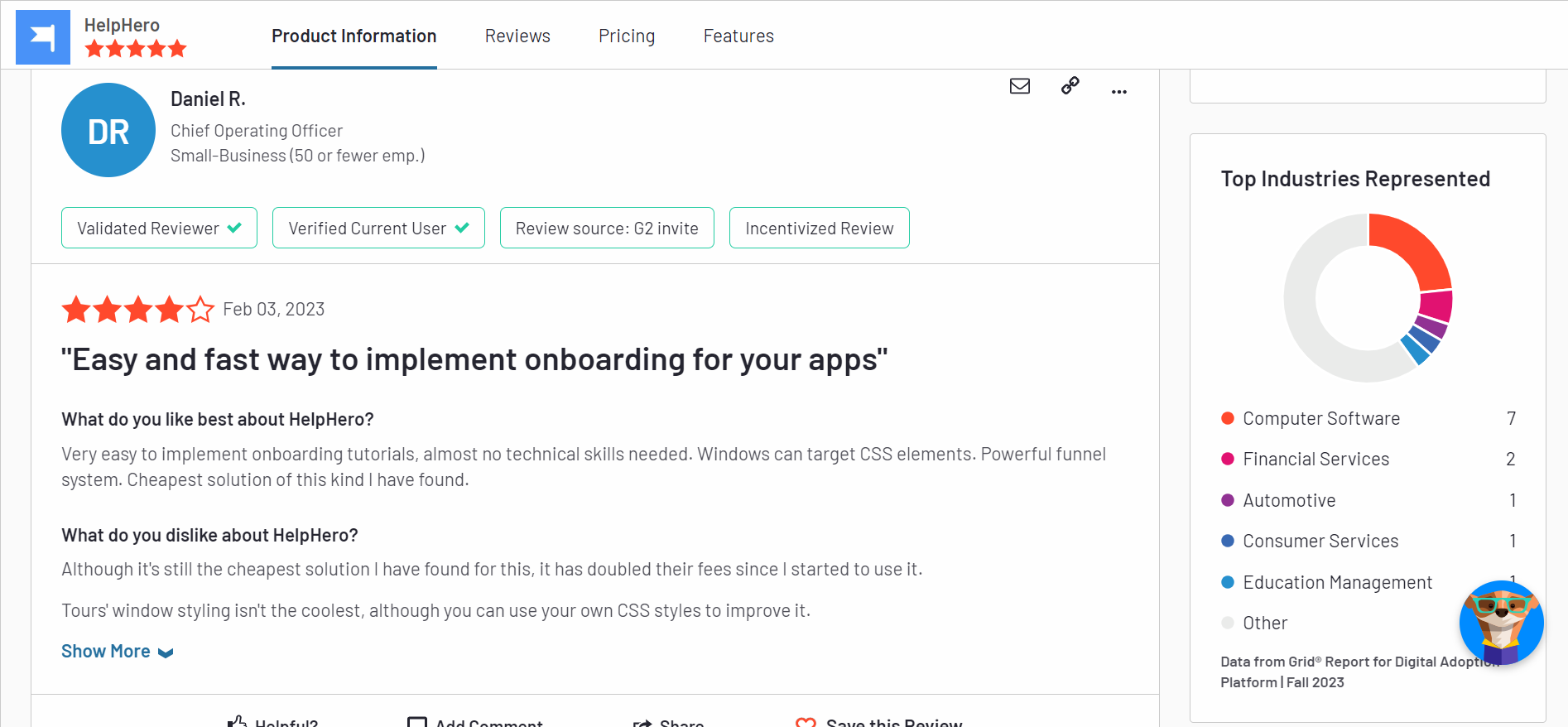
Although it’s still the cheapest solution I have found for this, it has doubled their fees since I started to use it.
Tours’ window styling isn’t the coolest, although you can use your own CSS styles to improve it.
HelpHero’s pricing
HelpHero’s pricing plan is based on the number of Monthly Active Users (MAUs). Here’s an overview of the different pricing plans, including the free trial:
- HelpHero free trial: free 14-day trial, no credit card required.
- Up to 1000 MAU — $55
- Up to 2500 MAU — $115
- Up to 5000 MAU — $179
- Up to 10000 MAU — $249
- Up to 20000 MAU — $299
- If you have more than 20,000 Monthly Active Users, you have to contact them.
3 Reasons why you might need a HelpHero alternative
Let’s look at the most common limitations of HelpHero and why you might need HelpHero’s alternatives:
- You want flexible user onboarding flows: HelpHero’s user onboarding features primarily support linear paths with minimal branching capabilities. This limitation can hinder the creation of more sophisticated and adaptable onboarding experiences, which is crucial for addressing the diverse needs of users.
- You want advanced interactivity options: HelpHero’s onboarding tools are somewhat restricted when creating interactive elements beyond basic text copy and buttons. To engage users effectively, especially in complex or feature-rich applications, a lack of interactive components can be a significant drawback.
- Inability to address specific user queries: HelpHero’s onboarding flow doesn’t allow users to drill into specific issues or questions they may have during the onboarding process. This limitation can make it challenging to provide real-time assistance and guidance to users, potentially leading to frustration or increased support requests.
Userpilot – A better alternative for Customer satisfaction
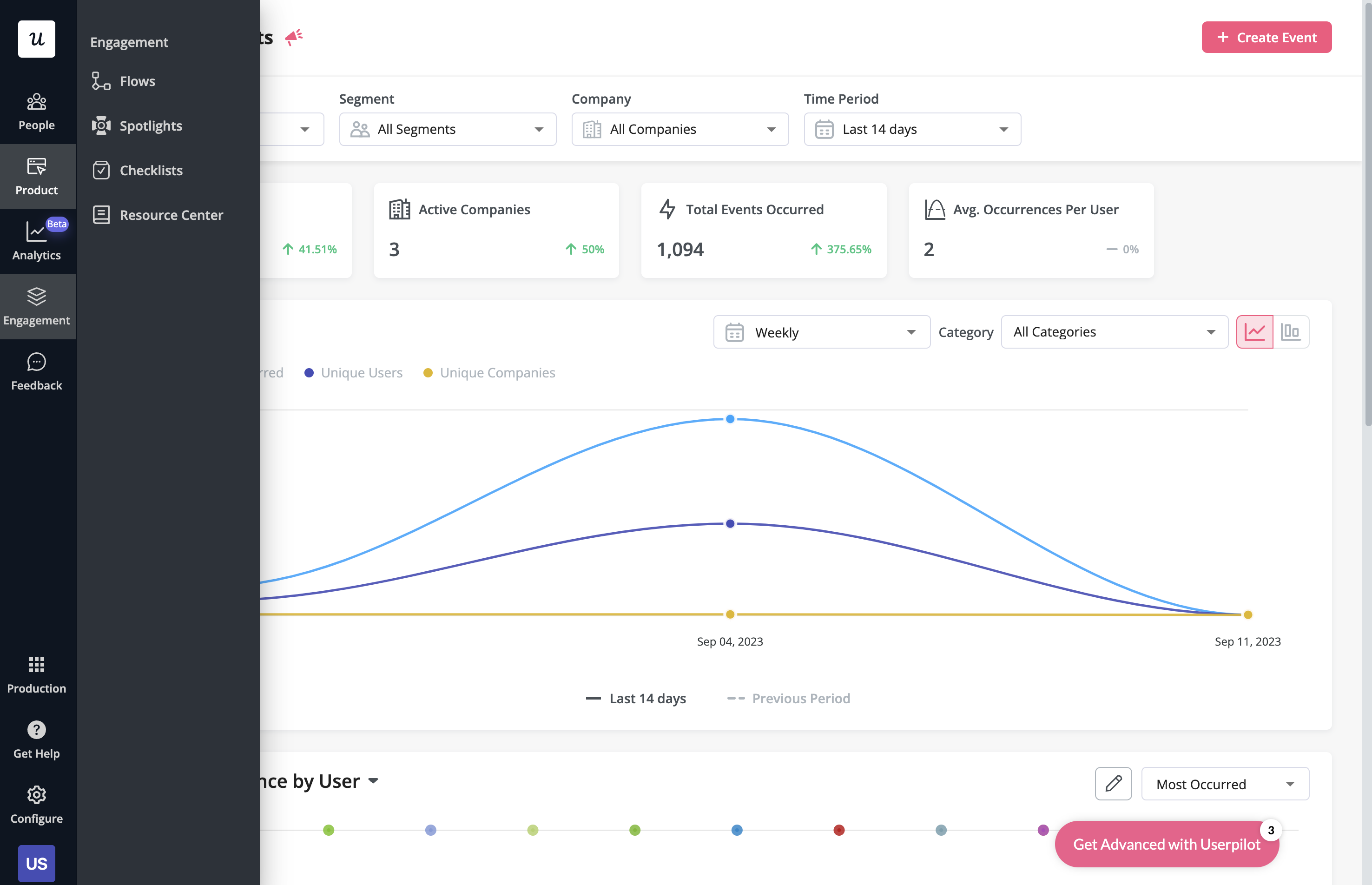
Here’s how you can use Userpilot to track and analyze customer experience insights:
- User analytics: The users dashboard gives you an overview of all your users while letting you sort by segment, company, or when they were last seen. You can also export user data in bulk as a CSV or click on the Insights tab to see segment-specific insights for a given time period.
- Trends and funnels: Userpilot’s trends and funnels reports let you track certain events like a specific feature’s usage, add filters to narrow down the data, and then create a breakdown based on segmentation data or user attributes — offering quick and actionable CX reports.
- Satisfaction benchmarking: Userpilot has a built-in NPS dashboard that tracks customer loyalty over time. In addition to the NPS dashboard, you can also use Userpilot’s survey templates to run CSAT or CES surveys and gather additional quantitative and qualitative insights on the customer experience.
- Self-service support: Userpilot lets you build in-app resource centers, which can include feedback widgets to collect feedback passively, checklists to walk users through specific processes, or integrations with knowledge bases to leverage existing documentation.
- In-app flows: Userpilot’s no-code flow builder helps you create product experiences that can help you optimize the customer experience by educating customers and reducing their time-to-value (TTV). All UI patterns are available on every Userpilot plan from Starter to Enterprise.
Userpilot’s user journey mapping
User journey mapping helps you visualize all the interactions between users and your product as they try to achieve a particular goal. Userpilot’s detailed user analytics and funnel/trend reports help you track customers as they progress through different stages of their journey.
Here are the Userpilot features you can use for user journey mapping:
- User analytics: The Users dashboard provides detailed analytics of your entire customer base. You’ll be able to sort by segment, company, or time period and add multiple filters to help you narrow results. You can also perform bulk actions and export user data in a CSV format.
- Funnel reports: These reports help you visualize the user journey map by showing which stage, page, or action most users get stuck on. You’ll also be able to view breakdowns so you can see how the user journey changes depending on which OS, browser, or device type a user is on.
- Trend reports: Userpilot’s trend reports offer behavioral insights such as how often users perform a specific action, the number of unique users who take that action, and where in the user journey these actions occur. You can also create custom metrics and build your own charts.
Userpilot’s self service support
Self-service support helps users solve problems themselves instead of having to reach out to a representative. Userpilot’s no-code resource center makes onboarding guides and product documentation easily accessible to users from within your product.
Here’s how you can use Userpilot to create a self-service customer experience:
- No-code builder: Userpilot’s no-code resource center lets you add modules without writing a single line of code. Module options include links, videos, flows, custom JavaScript functions, and checklists. You can also group modules into sections to help users navigate the resource center.
- Module segmentation: Userpilot’s segmentation settings let you hide or show specific modules within your resource center based on audience settings. This makes it possible to create modules for different user segments and hide resources that aren’t relevant to other users.
- Analytics dashboard: The dedicated analytics dashboard helps you see how many unique visitors your resource center gets, how many modules have been clicked, and the overall click rate across your user base. This will make it easier to gauge resource center performance.
Userpilot’s in-app support
In-app support can increase customer satisfaction and retention rates. Userpilot has native in-app support features like resource centers and native tooltips as well as third-party integrations with popular support tools like Intercom to help you cover all your bases.
Here’s an overview of Userpilot’s in-app support capabilities:
- Resource center: Userpilot in-app resource centers let you add flows, checklists, external links, tutorial videos, external knowledge bases, and chatbots. You’ll also be able to view resource center analytics so you can check its performance.
- Native tooltips: In-app support must be proactive — which is why you should insert tooltips that guide users before they even think to open the resource center. Userpilot lets you add native tooltips that appear whenever users hover over an element or click on the info badge.
- Contextual flows: Userpilot’s trigger settings let you create contextual flows that automatically appear when a user reaches a certain page or performs a specific action. This can be used to offer in-app guidance and support whenever users try out a feature for the first time.
- Intercom integration: While Intercom is famous for its live chat embeds, you can do more than that by integrating it with Userpilot. You’ll see which events a user has done within Userpilot and whether or not they’ve completed onboarding to personalize support accordingly.
Userpilot’s Interactive user guides
Interactive user guides can help users figure out how to use your product and get them towards activation faster. Here are the Userpilot features you can use for creating interactive guides:
- No-code builder: Userpilot lets you build in-app guides using modals, slideouts, banners, etc., without writing any code. You can also tinker with audience settings to target specific segments or exclude users who meet certain conditions from seeing a particular flow.
- Spotlight elements: The spotlight feature lets you add standalone UI elements like tooltips, hotspots, and driven actions that aren’t part of a multi-step flow. This makes it possible to display contextual guidance when users hover over a feature they’re interested in.
- Funnel reports: Userpilot’s advanced analytics capabilities include funnel reports that show you which pages or actions most users get stuck on. This can help you identify confusing or high-friction areas that can be removed through contextual interactive user guides.
What are the pros and cons of Userpilot?
Userpilot pros
As a full-suite digital adoption platform, Userpilot has all the features you need to onboard users, track analytics, and gather feedback from customers without writing a single line of code. Here are a few pros of using Userpilot as your product growth solution:
- No-code builder: Userpilot’s Chrome extension lets you build flows, add UI elements, and tag features without writing a single line of code.
- UI patterns: There are plenty of UI patterns to choose from when using Userpilot, such as hotspots, tooltips, banners, slideouts, modals, and more!
- Startup-friendly: Userpilot’s entry-level plan gives you access to all available UI patterns so you can hit the ground running.
- Walkthroughs and flows: Build engaging interactive walkthroughs and personalized onboarding flows that target specific segments of your user base.
- Self-service support: Build an in-app resource center to help users solve problems, customize its appearance to align it with your brand, and insert various types of content (videos, flows, or chatbots) to keep your customers satisfied.
- A/B testing: Userpilot’s built-in A/B testing capabilities will help you split-test flows, iterate on the best-performing variants, and continually optimize based on user behavior.
- Feedback collection: Userpilot has built-in NPS surveys with its own unified analytics dashboard and response tagging to help you retarget users. There are other survey types to choose from and you can even create your own custom survey.
- Survey templates: There are 14 survey templates to choose from so you can gather feedback on specific features or run customer satisfaction benchmarking surveys like CSAT and CES.
- Advanced analytics: Userpilot lets you analyze product usage data, monitor engagement on all in-app flows, and use the data to create user segments that are based on behaviors instead of demographics.
- Event tracking: Userpilot’s no-code event tracking lets you tag UI interactions (hovers, clicks, or form fills) and group them into a custom event that reflects feature usage.
- Third-party integrations: Userpilot has built-in integrations with tools like Amplitude, Mixpanel, Kissmetrics, Segment, Heap, HubSpot, Intercom, Google Analytics, and Google Tag Manager so you can share data between all the solutions in your tech stack.
Userpilot’s cons
Of course, no tool is perfect and there are a few cons to consider before choosing Userpilot as your user onboarding or product growth solution:
- Employee onboarding: Currently, Userpilot only supports in-app customer onboarding.
- Mobile apps: Userpilot doesn’t have any mobile compatibility which could make it difficult for developers with cross-platform applications to create a consistent user experience for both versions of their product.
- Freemium plan: There’s no freemium Userpilot plan so those bootstrapping their startup and need sub-$100 solutions should consider more affordable onboarding platforms like UserGuiding or Product Fruits.
What do users say about Userpilot?
Most users laud Userpilot for its versatile feature set, ease of use, and responsive support team:
I recently had the pleasure of using Userpilot, and I must say it exceeded all my expectations. As a product manager, I’m always on the lookout for tools that can enhance user onboarding and improve overall user experience. Userpilot not only delivered on these fronts but also went above and beyond with its impressive new features, unparalleled ease of use, and truly exceptional customer support.
What truly sets Userpilot apart is its outstanding customer support. Throughout my journey with Userpilot, the support team has been responsive, knowledgeable, and genuinely dedicated to helping me succeed. Whenever I had a question or encountered an issue, their support team was always there to assist promptly, going above and beyond to ensure my concerns were addressed effectively.
Source: G2.Of course, other users are also kind enough to share constructive criticism regarding specific features like event tracking filters:
“The filtration while analyzing specific events is a little confusing. Understanding of custom properties and data management configuration could have been more organised.”
Source: G2.
Userpilot’s pricing
Userpilot offers flexible pricing based on your monthly active users (MAUs). Plans start at $299 per month for smaller teams and scale as your user base grows.
Below are the pricing tiers you can choose from:
- The Starter plan begins at $299/month (billed annually) for up to 2,000 monthly active users. It includes in-app user engagement, usage trend analysis, NPS surveys, and essential product analytics—ideal for mid-market SaaS teams getting started.
- The Growth plan offers custom pricing and adds advanced analytics, retroactive event auto-capture, in-app surveys, session replay, and more. It’s the most popular choice for growing teams that need deeper insights and scale.
- The Enterprise plan offers custom pricing and includes everything in Growth, plus bulk data handling, custom roles and permissions, SOC 2 Type 2 compliance, and enterprise-level support.

Conclusion
There you have it.
It should be easier now to make an informed decision whether HelpHero is your go-to option for Customer satisfaction. Ultimately, the best choice will depend on your product and current needs.
If you’re looking for a better alternative to HelpHero for Customer satisfaction, book a Userpilot demo today to experience firsthand how it can enhance your user experience and drive product growth!
Looking for A Better Alternative for Customer satisfaction? Try Userpilot


